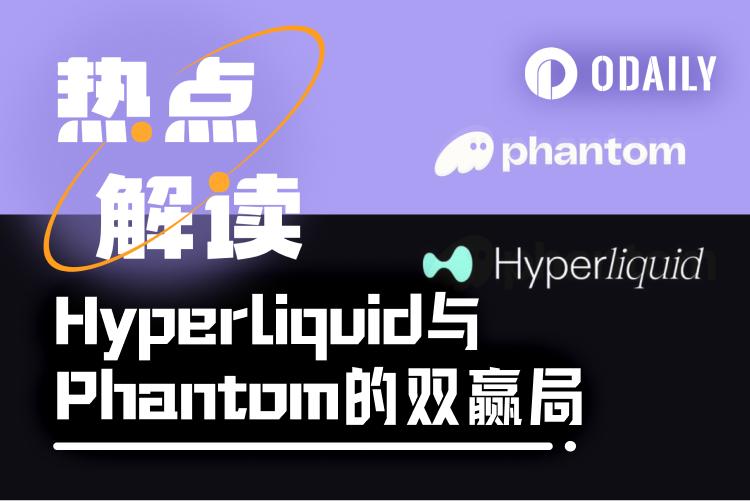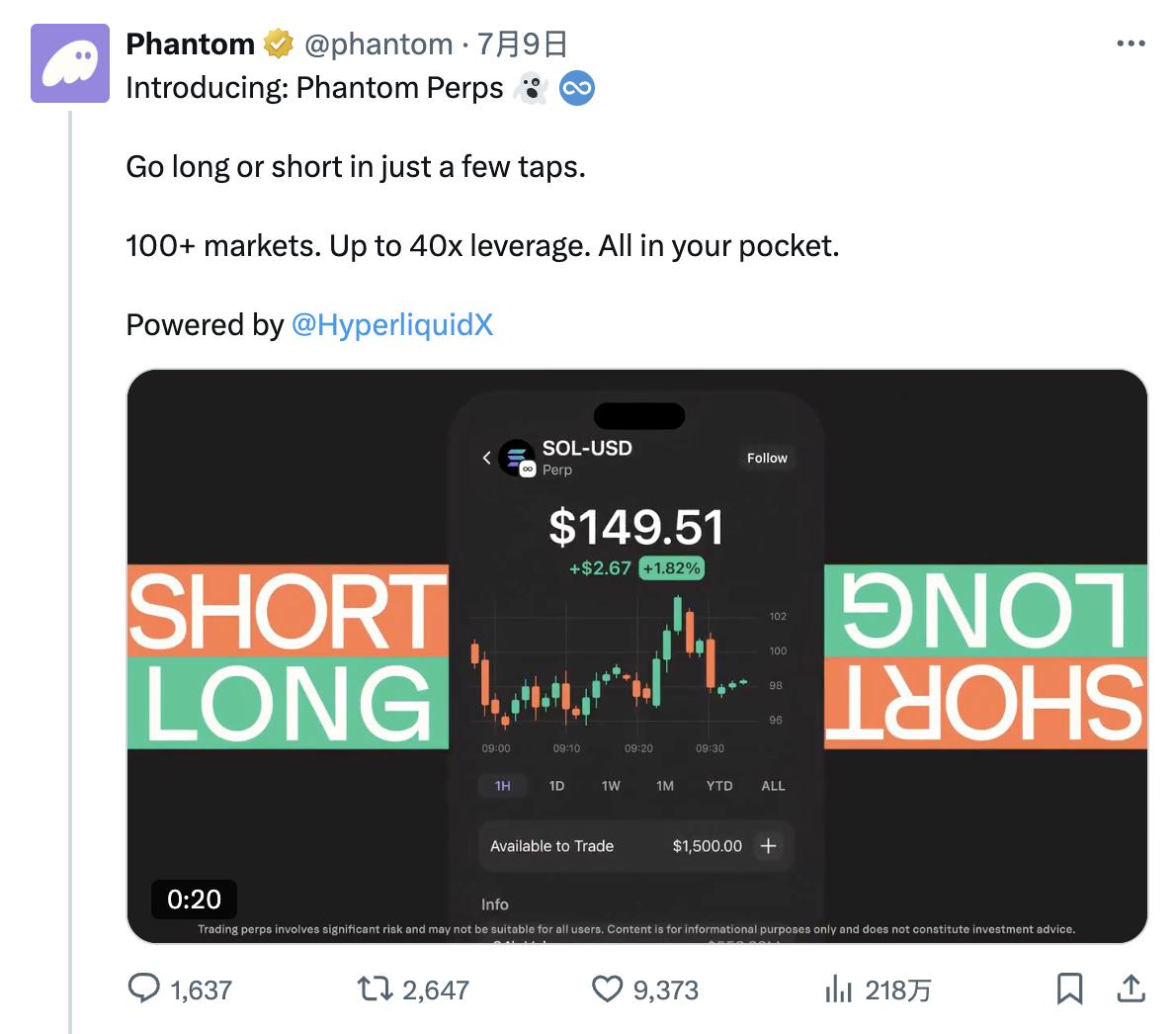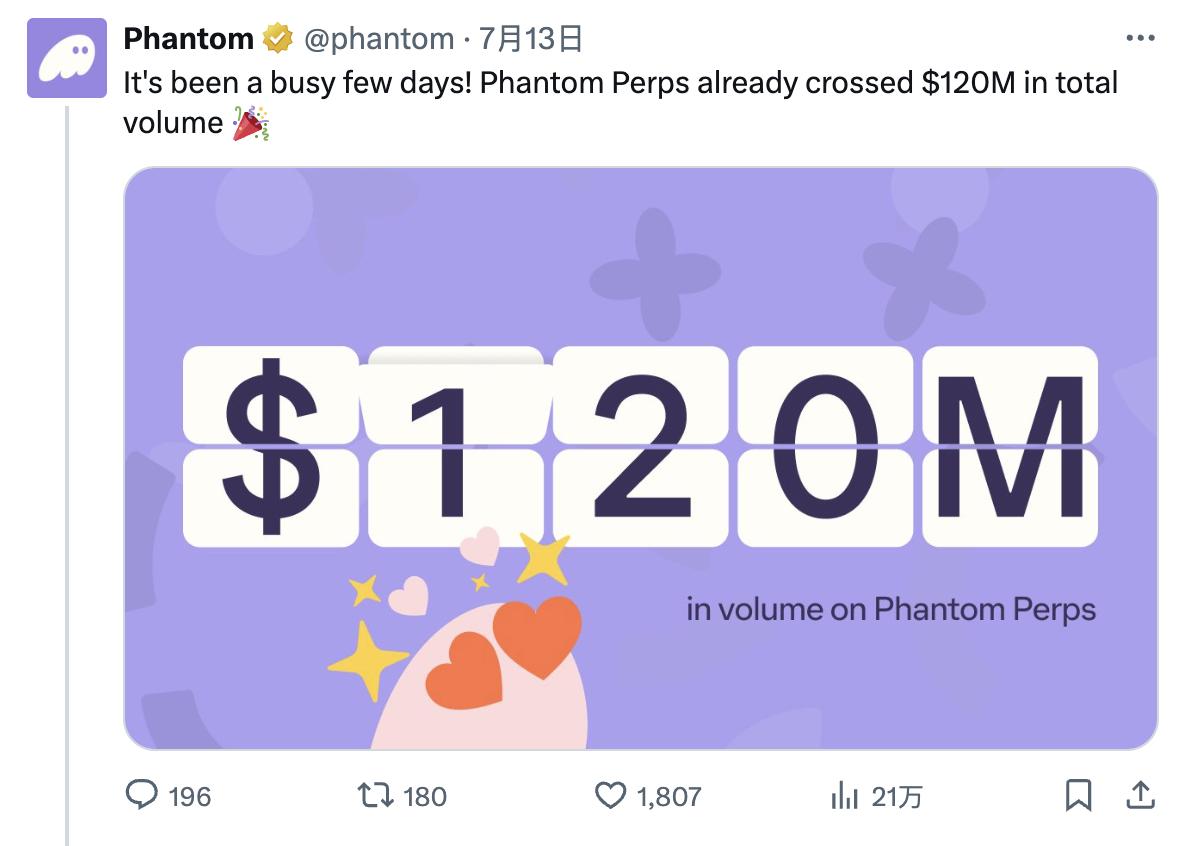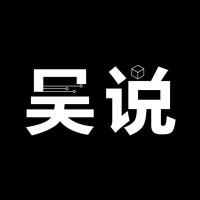Original | Odaily (Odaily Planet Daily) (@OdailyChina)
Author | Azuma (@azuma_eth)

On July 9, Solana's mainstream wallet application Phantom announced a partnership with decentralized exchange Hyperliquid, leveraging Hyperliquid's backend support to allow Phantom users to directly trade perpetual contracts within the wallet, with up to 40x leverage for long or short trading on over 100 tokens supported by Hyperliquid.

Although only 5 days have passed since the partnership was reached, it is almost certain that this collaboration is a win for both Phantom and Hyperliquid.
Hyperliquid: Reaching Solana Ecosystem, Token Price Breaks New High
First, from Hyperliquid's perspective, as the most momentum-driven decentralized contract exchange, Hyperliquid's previous main battleground was in the EVM ecosystem. Although some Solana DeFi projects (like Ranger) have attempted to connect services, the overall reach to Solana users was not ideal. With the completion of the partnership, Hyperliquid will use Phantom, the most mainstream wallet application in the Solana ecosystem, to directly and efficiently reach Solana ecosystem users.
According to official data disclosed by Phantom in January this year, the wallet currently has 15 million monthly active addresses, which means that even if only 1% of addresses are converted, it will bring 150,000 new users to Hyperliquid - with Hyperliquid's current total user count of around 540,000, this represents nearly a 30% user increase.

Additionally, Phantom disclosed that the exchange service built into its wallet facilitated 850 million transactions in 2024, with a trading volume of $20 billion. Currently, the ratio of spot trading volume to contract trading volume on mainstream centralized exchanges is about 15% - 30% - even using the conservative 30% data, this corresponds to an expected contract trading volume of about $66 billion.
On the morning of July 13, Phantom officially revealed that its contract trading volume had exceeded $120 million, just 4 days after launching the contract trading feature, which is already an impressive start.

Influenced by the growth expectations from this partnership, Hyperliquid's token HYPE has been continuously reaching new highs, reporting $49.13 as of July 14 at 15:45, just short of breaking the $50 mark.
Phantom: "Rebate" Passive Income
For Phantom, this partnership is also highly significant. On one hand, introducing contract trading enriches Phantom's product functionality and provides users with more diverse service content; on the other hand, by leveraging Hyperliquid's Builder Codes feature, Phantom can also expect a considerable new source of income.
Builder Codes allow third-party Builders (in this case, Phantom) to earn transaction fees by representing user transactions, which can be simply understood as a "rebate" mechanism.
Hyperformance data shows that just 5 days after launching the contract trading service, Phantom's "rebate" address has earned $102,155 in Builder codes income.

Even based on static calculations, this corresponds to an annual income of about $7.45 million, and considering user and trading volume growth expectations, this figure could potentially multiply several times.
User Perspective: Better Liquidity, Lower Fees
From the perspective of Solana ecosystem users, Phantom's collaboration with Hyperliquid is clearly a blessing. On one hand, Hyperliquid's liquidity has a significant advantage over current Solana ecosystem contract exchanges, which will provide better trading execution prices for Solana ecosystem users; more critically, Phantom and Hyperliquid offer users extremely attractive fee conditions.
GLC Research in its latest research noted that the median fee provided by Phantom and Hyperliquid is 0.095%, compared to Jupiter's contract trading fee of 0.3%, showing a clear fee advantage.
Overseas KOL JJ (@hyperliquidbull) added that Phantom and Hyperliquid provide users with near-institutional-level fee pricing, almost equivalent to Binance's VIP-1 pricing, which typically requires over $15 million in monthly trading volume.
Conclusion: The Future of Chain Abstraction
The most interesting point about this Phantom and Hyperliquid collaboration is that, as a main player in the Solana ecosystem, Phantom did not choose Solana ecosystem decentralized contract exchanges like Jupiter or Drift, but instead cross-ecosystem selected Hyperliquid, with all integration work completed on the backend, completely imperceptible to frontend users.
This is almost the chain abstraction future we once envisioned - products will no longer be limited by their native stack, complex technologies and concepts will be hidden behind the scenes, and users will directly enjoy convenient services without awareness.
As top players in different tracks, Phantom and Hyperliquid have provided a good example through this collaboration, which may offer some reference for subsequent industry collaboration and innovation.







